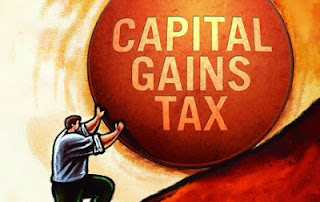The debates are over and we are now less than two weeks from the election! There's a lot riding on this election for both nominees and both parties, but more importantly, for the American public as a whole. While there are numerous issues that will no doubt require the next President's attention, along with that of our lawmakers, few issues are likely to generate more interest from the American people than the subject of taxes.

For some time now, we've had it pretty good, at least from a tax perspective. That's all about to change though. There are an abundance of changes to the tax law scheduled to take effect in 2013 and they are almost universally going to take a bigger chunk of your money and hand it over to Uncle Sam. Old or young, rich or poor, it really won't matter. If nothing changes between now and the end of the year, you're likely to pay more in taxes next year than you are this year. While ordinary income tax rates get much of the press, there are a lot more ways your tax bill might rise. With that in mind, let's take a look at 10 ways you could very well pay more tax in 2013 than you will in 2012.
Ordinary Income Tax Rates
The Bush era tax cuts that were extended in 2010 are set to expire at the end of this year. If that happens and Congress takes no action, rates for most taxpayers, on both ends of the income spectrum, would increase. For instance, right now those who pay tax at the lowest rate pay just 10% in federal income tax. That number would jump to 15% next year. Similarly, the very highest income tax rate one can pay in 2012 is 35%. The highest rate in 2013, if nothing changes, will be 39.6%.
Sources of income that are subject to ordinary income tax rates include your salary, self-employment income, alimony, interest, short-term capital gains and the portion of your Social Security included in gross income.
Capital Gains
If you hold a capital asset for longer than one year, you get a special tax break on any profit when you sell it. Instead of having the profits subject to ordinary income tax rates, you get to pay tax at long-term capital gains rates, which are more favorable. Like the ordinary rate increases we’re set to see in 2013, the changes in the long-term capital gains rates will impact you, no matter what end of the income spectrum you happen to be on. Currently, if your marginal ordinary rate (the highest ordinary income tax rate you pay tax at) is 10% or 15%, you don’t pay any tax on long-term capital gains. If nothing changes, that nice 0% rate (sure can’t beat that) will become up to 10% next year. At the other end of the spectrum, the maximum long-term capital gains rate is 15% (a savings of almost 60% when compared to the top ordinary rate of 35%). Barring Congressional action between now and next year, the top long-term capital gains rate will be 20%.
Long-term capital gains rates apply to the profits on capital assets held longer than one year. Capital assets include stocks, bonds and real estate, including any portion of your primary residence that is not excluded from income.
Qualified Dividends
The economy generally runs better when people are investing their money in businesses and not just leaving it in the bank. In an effort to encourage more people to invest in businesses, Congress created a special tax break for “qualified dividends,” which are simply dividends that have met certain criteria outlined in the Tax Code. Once again, if nothing changes, taxpayers of all income levels will be hit harder in 2013. The current tax rates for qualified dividends are the same as long-term capital gains rates. If you are in the 10% or 15% marginal ordinary income tax bracket you pay a 0% tax rate on qualified dividends. If you are in one of the higher brackets, you pay a 15% rate.
The rate on qualified dividends isn’t simply scheduled to increase next year. Oh no… it’s much worse. Qualified dividends, as things stand now, won’t even exist next year. Instead of getting a tax break, dividends will be taxed at ordinary income tax rates at whatever marginal bracket you happen to be in, just like your interest is now.
FICA
In 2011 Congress passed what was widely referred to as the “payroll tax holiday.” In essence, it was a one year reduction, from 6.2% to 4.2%, in the amount of FICA (Social Security) taxes taken out of a worker’s paycheck. Self-employed persons received a similar break. The tax break was popular enough that is was later extended through the end of 2012. To this point, Congress has taken no action to further extend this deadline, so workers can expect to see more money taken out of their checks for FICA beginning January 1st.
Once again, taxpayers at all ends of the spectrum will feel the pinch. The 6.2% FICA rate scheduled to be in effect for 2013 is a flat rate, meaning those who earn $10,000 salaries will pay the same 6.2% rate that those making $100,000 will. Those with substantial earned income will not only see their FICA tax rate increase, but more of their income will be subject to the tax. In 2012, only the first $110,100 of earned income was subject to the tax. In 2013, up to $113,700 of earned income will be subject to the tax. As a result, those with high income could pay nearly $2,500 more in FICA tax next year.
The FICA tax is assessed on earned income, both from wages and self-employment. You cannot reduce your FICA tax with deductions on your return.
3.8% Health care Surtax
As if it’s not bad enough that nearly all the rates on various types of personal income are set to increase next year, we’re going to add a brand new tax to the mix as well. If you are a high-income taxpayer, beginning in 2013, you may be hit with an additional 3.8% surtax on all or a portion of your “net investment income.” This 3.8% surtax only applies if your net investment income is above your applicable threshold. If you are married and file a joint return, the threshold is $250,000. If you are single, the threshold is $200,000.
The 3.8% surtax will be assessed on the lesser of the amount of income you are over your applicable threshold or your total sum of investment income. Investment income includes capital gains, interest, dividends, taxable distributions from non-qualified (not retirement account) annuities and rental income (unless that is your business). Earned income, as well as IRA and other retirement account distributions, are not net investment income, but could increase your total income, causing other net investment income to become subject to the surtax.
0.9% Medicare Surtax
Is all your income earned income? If so, you don’t have to worry about the 3.8% surtax on net investment income, but that doesn’t mean you’re out of the woods either. Beginning in 2013 certain higher earners will be hit with an additional 0.9% Medicare Tax (
we wrote a Tuesday article about this tax). The thresholds for the new Medicare surtax are the same as the thresholds for the 3.8% healthcare surtax, except here, the only income considered is earned income. Married couples who file a joint return and have combined earned income above $250,000 will be hit with the 0.9% surtax on any excess above that amount. If you are a single filer, you’ll be affected in a similar manner, but on earned income exceeding $200,000.
Earned income includes both wages (salary from an employer) and self-employment income.
Return of Exemption Phase-outs
The loss of personal exemptions is yet another way your tax bill might be a higher in 2013. Under the current law, there is no limit to the amount of income you can have in order to claim personal exemptions. To put it another way, in 2012, even Bill Gates and Warren Buffet can claim personal exemptions. Unless Congress takes action to extend this benefit, the same will not be true next year. Married couples filing a joint return will begin to see their personal exemptions phased out at around $260,000. Single filers will start to see their exemptions phased out at about $175,000 of income (although the President’s budget calls for that number to be closer to $210,000).
In general, you are allowed a personal exemption for yourself and, if you are married and file a joint return, one for your spouse as well. If you claim any dependents, such as a children, you can generally claim an exemption for them as well. An exemption for the same person cannot be claimed on multiple tax returns.
Estate Tax
I hope you’re sitting down for this one. If nothing changes between now and next year things in the estate tax area are about to get bad… real, real bad. Beginning in 2013, there will be three major changes to the estate tax law, and all of them could cause you to pay more taxes. A lot more. The first major change to the estate tax is that the exemption amount is scheduled to drop from the current $5,120,000 all the way back down to $1,000,000. In other words, right now, as long as the total value of your taxable estate is less than $5,120,000 you will owe no federal estate tax, but next year, if your taxable estate value exceeds just $1,000,000 your estate will be subject to federal estate tax.
The second big change to the estate tax law beginning in 2013 is that the rate, itself, is scheduled to increase. As noted above, right now the first $5.12 million you leave to someone other than your spouse can generally pass completely estate tax free. However, if you happen to have an estate with a total value in excess of that amount and you pass away in 2012, any excess would only be hit with a maximum estate tax rate of 35%. In contrast, for deaths occurring on or after January 1, 2013, the maximum estate tax rate is set to increase to 55%! Yep, that’s right. A whole lot more of your estate could be hit with a tax that’s a whole lot higher.
The final big change to the estate tax law that’s scheduled to take place in 2013 and could cause you to pay a lot more in tax is the loss of “portability.” In essence, portability is simply a way to transfer any exemption you have remaining after your death to a surviving spouse without the need for any sophisticated estate planning. If you are married, this can effectively double the amount of assets you can pass estate tax free to children, grandchildren, etc. to $10.24 million. At that number, very few estates should be hit with estate tax. In the past, preserving one’s exemption for a surviving spouse was impossible and the only way to make use of the exemption at the time of the first spouse’s death was to give assets immediately to someone other than the surviving spouse or to use of a special type of trust, known as a credit shelter, or A-B trust. For those passing away in 2013 or later with estates in excess of $1 million, credit shelter trusts may once again become a critical planning vehicle.
The only good news in this area is that it seems like both Republicans and Democrats agree that the estate tax laws for 2013, as scheduled now, seem a little harsh. Though they disagree on the extent of the relief they want, the fact that there is common ground might be cause for optimism that at least some facet of the estate tax law (e.g. the rate or exemption) will be made more palatable.
Gift Tax
The current lifetime gift tax exemption is $5.12, just like the estate tax exemption. The two exemptions are actually unified, meaning that any amount you give away during life that eats into your lifetime gift tax exemption will reduce the amount you can transfer after death estate tax free. For instance, if you gifted $2 million to a child last year and pass away before the end of this year, you can still pass $3.12 million ($5.12 current exemption - $2 million gifted in life). Like the estate tax exemption, the gift tax exemption is scheduled to drop to $1 million. Therefore, if you have a large estate, making a large gift before the end of 2012 should be a topic of conversation between you and your tax and/or financial advisor.
Note: In 2012 you can gift $13,000 per person before using any of your lifetime exemption. In 2014 that amount is increasing to $14,000.
The gift tax issues for 2013 also mirror the estate tax issues in other ways. For instance, like the estate tax, the gift tax rate is scheduled to increase from the current maximum of 35% to 55%. The gift tax exemption is also portable in 2012, a feature that is set to be eliminated beginning in 2013.
GST Tax
The Generation Skipping Transfer, or GST, tax is one of the taxes you pretty much want to do anything possible to avoid (I said avoid, not evade! I know this seems bleak, but don’t go getting any funny ideas on me now.) The GST tax is an additional tax on top of either estate or gift tax, when you transfer property down more than one generation. Most commonly, this comes into play when you are gifting (during life) or bequeathing (after death) your assets to a grandchild or great grandchild, although gifts to non-relatives 37 ½ years or more younger than you would also be hit with the tax.
Under the current law, the GST exemption is $5.12 million. Sound familiar? That means you can give/leave up to $5.12 million to a grandchild completely transfer (gift/estate and GST) tax free. That opens the door for some serious legacy and multi-generation planning opportunities. Those opportunities are not going to stick around forever though. As it stands now, the GST exemption is scheduled to go back down to $1 million in 2013.
Note: Unlike the estate and gift tax exemptions, the GST tax exemption is not portable.
The current GST tax rate is also a “favorable” 35%. Beginning in 2013, that rate, like the estate and gift tax rates, is scheduled to go back up to 55%. That 55%, if nothing changes, could be imposed along with a 55% estate or gift tax. It’s also worth remembering that transfer (estate, gift and GST) taxes are imposed not on the recipient(s) of the assets, but rather, on the donor.
- By Jeff Levine and Jared Trexler











